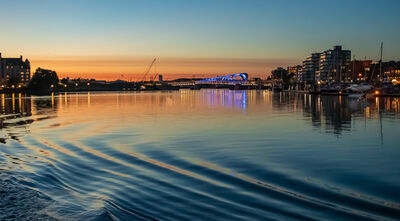S & E Asia 143 - Northern Thailand 01: Intro & glimpses of upcoming tour highlights
Oct 24, 2022 10:58:21 #
After a long absence due to our vacation- and family-visit time spent over in Europe during August and September, and extended by a bout of Covid-19 that we managed to pick up while in transit during the return travel at the Paris airport, I am eager to continue to present the images and experiences of our 2013 Asia Trip.
In this third segment of our travelogue through SOUTH & EAST ASIA, I will cover the KINGDOM OF THAILAND. Compared to the other two segments already covered (Sichuan in Western China and neighboring Myanmar), Thailand will most likely be more familiar to many of our viewers from news coverage or actual visits, particularly so of course the country's capital city Bangkok or its beach and party locations such as Patthaya, Phuket, Koh Samu, Kraby, etc. - Our destinations in this presentation will be different though and, except for a few initial posts on the capital city Bangkok, will cover our driving tour from Bangkok north, visiting on the way places with significant cultural treasures, many of them even former capital cities of parts now included in the Kingdom of Thailand. Buddhism is also quite ingrained into the texture of this beautiful country, though possibly not as deeply as we saw evidenced in neighboring Myanmar. Besides visiting these cultural treasures, we will also catch glimpses of Thailand's gentle countryside as well as episodes of the lives of ordinary people in the streets and fields.
As it is my usual practice, I will start with a rather lengthy, but actually much condensed overview of the country's history and geography. Hopefully this will help to provide the overall context and make the images presented more understandable. I will reference this introductory page in all subsequent postings of Thailand.
GENERAL HISTORICAL OVERVIEW
Tai peoples migrated from southwestern China to mainland Southeast Asia from the 11th century. Indianized kingdoms such as the Mon, Khmer Empire and Malay states ruled the region, competing with Thai states such as the Kingdoms of Ngoenyang, Sukhothai, Lan Na and Ayutthaya, which also rivalled each other. European contact began in 1511 with a Portuguese diplomatic mission to Ayutthaya, which became a regional power by the end of the 15th century. Ayutthaya reached its peak during the cosmopolitan Narai's reign, gradually declining thereafter until being ultimately destroyed in the Burmese–Siamese War. Taksin quickly reunified the fragmented territory and established the short-lived Thonburi Kingdom. He was succeeded in 1782 by Buddha Yodfa Chulaloke, the first monarch of the current Chakri dynasty.
Throughout the era of Western imperialism in Asia, Siam remained the only nation in the region to avoid colonization by foreign powers, although it was often forced to cede both territory, trade and legal concessions in unequal treaties. The Siamese system of government was centralized and transformed into a modern unitary absolute monarchy in the reign of Chulalongkorn. In World War I, Siam sided with the Allies, a political decision made in order to amend the unequal treaties. Following a bloodless revolution in 1932, it became a constitutional monarchy and changed its official name to Thailand, becoming an ally of Japan in World War II. In the late 1950s, a military coup under Field Marshal Sarit Thanarat revived the monarchy's historically influential role in politics. Thailand became a major ally of the United States, and played an anti-communist role in the region as a member of the failed SEATO, but from 1975 sought to improve relations with Communist China and Thailand's neighbors.
Apart from a brief period of parliamentary democracy in the mid-1970s, Thailand has periodically alternated between democracy and military rule. Since the 2000's the country has been caught in continual bitter political conflict between supporters and opponents of Thaksin Shinawatra, which resulted in two coups (in 2006 and 2014), along with the establishment of its current constitution, a nominally democratic government after the 2019 Thai general election, and ongoing pro-democracy protests that began in 2020.
Thailand is a middle power in global affairs and a founding member of ASEAN, and ranks high in the Human Development Index. It has the second-largest economy in Southeast Asia and the 22nd-largest in the world. Thailand is classified as a newly industrialized economy, with manufacturing, agriculture, and tourism as leading sectors.
GEOGRAPHY
Totaling 513,120 km² (198,120 sq mi), Thailand is the world's 50th-largest country by total area. It is slightly smaller than Yemen and slightly larger than Spain.
Thailand comprises several distinct geographic regions, partly corresponding to the provincial groups. The north of the country is the mountainous area of the Thai highlands, with the highest point being Doi Inthanon in the Thanon Thong Chai Range at 2,565 m (8,415 ft) above sea level. The northeast, Isan, consists of the Khorat Plateau, bordered to the east by the Mekong River. The center of the country is dominated by the predominantly flat Chao Phraya river valley, which runs into the Gulf of Thailand.
Southern Thailand consists of the narrow Kra Isthmus that widens into the Malay Peninsula. Politically, there are six geographical regions which differ from the others in population, basic resources, natural features, and level of social and economic development. The diversity of the regions is the most pronounced attribute of Thailand's physical setting.
The Chao Phraya and the Mekong River are the indispensable water courses of rural Thailand. Industrial scale production of crops use both rivers and their tributaries. The Gulf of Thailand covers 320,000 km² (124,000 sq mi) and is fed by the Chao Phraya, Mae Klong, Bang Pakong, and Tapi Rivers. It contributes to the tourism sector owing to its clear shallow waters along the coasts in the southern region and the Kra Isthmus. The eastern shore of the Gulf of Thailand is an industrial center of Thailand with the kingdom's premier deepwater port in Sattahip and its busiest commercial port, Laem Chabang.
The Andaman Sea is a precious natural resource as it hosts popular and luxurious resorts: Phuket, Krabi, Ranong, Phang Nga and Trang, and their islands, all lay along the coasts of the Andaman Sea and, despite the 2004 tsunami, they remain a tourist magnet.
Link to the full Wikipedia article on Thailand: https://en.wikipedia.org/wiki/Thailand
SPECIFIC TERMINOLOGY used in this section covering Thailand:
Chedi - Buddhist stupa, mainly used in Thailand
Loi Kra Thong - Festival of floating ritual vessels (see full description in post # 152)
Naga - Divine race of half-human, half-serpent beings that reside in the netherworld
Wat - Thai Buddhist monastery or temple
-------------------------------------------------------------------------------------------------------------------------------
In this first post covering Northern Thailand, I present the title page of my album identifying some of the major areas we will visit, a couple of maps of the trip and I add a small taster of scenes we will encounter over the next two months as we cover the northern part of Thailand.
Notes
TRIP INFO: Set # 1 provides a brief introduction to THIS SERIES on SOUTH & EAST ASIA. See it at
https://www.uglyhedgehog.com/t-724330-1.html
EARLIER POSTS of this series: Access my topic list at UHH, the new posts are listed in reverse chronological order:
https://www.uglyhedgehog.com/user-topic-list?usernum=45105
Thanks for visiting, for improved clarity please view the downloads. I look forward to your comments and questions.
.
In this third segment of our travelogue through SOUTH & EAST ASIA, I will cover the KINGDOM OF THAILAND. Compared to the other two segments already covered (Sichuan in Western China and neighboring Myanmar), Thailand will most likely be more familiar to many of our viewers from news coverage or actual visits, particularly so of course the country's capital city Bangkok or its beach and party locations such as Patthaya, Phuket, Koh Samu, Kraby, etc. - Our destinations in this presentation will be different though and, except for a few initial posts on the capital city Bangkok, will cover our driving tour from Bangkok north, visiting on the way places with significant cultural treasures, many of them even former capital cities of parts now included in the Kingdom of Thailand. Buddhism is also quite ingrained into the texture of this beautiful country, though possibly not as deeply as we saw evidenced in neighboring Myanmar. Besides visiting these cultural treasures, we will also catch glimpses of Thailand's gentle countryside as well as episodes of the lives of ordinary people in the streets and fields.
As it is my usual practice, I will start with a rather lengthy, but actually much condensed overview of the country's history and geography. Hopefully this will help to provide the overall context and make the images presented more understandable. I will reference this introductory page in all subsequent postings of Thailand.
GENERAL HISTORICAL OVERVIEW
Tai peoples migrated from southwestern China to mainland Southeast Asia from the 11th century. Indianized kingdoms such as the Mon, Khmer Empire and Malay states ruled the region, competing with Thai states such as the Kingdoms of Ngoenyang, Sukhothai, Lan Na and Ayutthaya, which also rivalled each other. European contact began in 1511 with a Portuguese diplomatic mission to Ayutthaya, which became a regional power by the end of the 15th century. Ayutthaya reached its peak during the cosmopolitan Narai's reign, gradually declining thereafter until being ultimately destroyed in the Burmese–Siamese War. Taksin quickly reunified the fragmented territory and established the short-lived Thonburi Kingdom. He was succeeded in 1782 by Buddha Yodfa Chulaloke, the first monarch of the current Chakri dynasty.
Throughout the era of Western imperialism in Asia, Siam remained the only nation in the region to avoid colonization by foreign powers, although it was often forced to cede both territory, trade and legal concessions in unequal treaties. The Siamese system of government was centralized and transformed into a modern unitary absolute monarchy in the reign of Chulalongkorn. In World War I, Siam sided with the Allies, a political decision made in order to amend the unequal treaties. Following a bloodless revolution in 1932, it became a constitutional monarchy and changed its official name to Thailand, becoming an ally of Japan in World War II. In the late 1950s, a military coup under Field Marshal Sarit Thanarat revived the monarchy's historically influential role in politics. Thailand became a major ally of the United States, and played an anti-communist role in the region as a member of the failed SEATO, but from 1975 sought to improve relations with Communist China and Thailand's neighbors.
Apart from a brief period of parliamentary democracy in the mid-1970s, Thailand has periodically alternated between democracy and military rule. Since the 2000's the country has been caught in continual bitter political conflict between supporters and opponents of Thaksin Shinawatra, which resulted in two coups (in 2006 and 2014), along with the establishment of its current constitution, a nominally democratic government after the 2019 Thai general election, and ongoing pro-democracy protests that began in 2020.
Thailand is a middle power in global affairs and a founding member of ASEAN, and ranks high in the Human Development Index. It has the second-largest economy in Southeast Asia and the 22nd-largest in the world. Thailand is classified as a newly industrialized economy, with manufacturing, agriculture, and tourism as leading sectors.
GEOGRAPHY
Totaling 513,120 km² (198,120 sq mi), Thailand is the world's 50th-largest country by total area. It is slightly smaller than Yemen and slightly larger than Spain.
Thailand comprises several distinct geographic regions, partly corresponding to the provincial groups. The north of the country is the mountainous area of the Thai highlands, with the highest point being Doi Inthanon in the Thanon Thong Chai Range at 2,565 m (8,415 ft) above sea level. The northeast, Isan, consists of the Khorat Plateau, bordered to the east by the Mekong River. The center of the country is dominated by the predominantly flat Chao Phraya river valley, which runs into the Gulf of Thailand.
Southern Thailand consists of the narrow Kra Isthmus that widens into the Malay Peninsula. Politically, there are six geographical regions which differ from the others in population, basic resources, natural features, and level of social and economic development. The diversity of the regions is the most pronounced attribute of Thailand's physical setting.
The Chao Phraya and the Mekong River are the indispensable water courses of rural Thailand. Industrial scale production of crops use both rivers and their tributaries. The Gulf of Thailand covers 320,000 km² (124,000 sq mi) and is fed by the Chao Phraya, Mae Klong, Bang Pakong, and Tapi Rivers. It contributes to the tourism sector owing to its clear shallow waters along the coasts in the southern region and the Kra Isthmus. The eastern shore of the Gulf of Thailand is an industrial center of Thailand with the kingdom's premier deepwater port in Sattahip and its busiest commercial port, Laem Chabang.
The Andaman Sea is a precious natural resource as it hosts popular and luxurious resorts: Phuket, Krabi, Ranong, Phang Nga and Trang, and their islands, all lay along the coasts of the Andaman Sea and, despite the 2004 tsunami, they remain a tourist magnet.
Link to the full Wikipedia article on Thailand: https://en.wikipedia.org/wiki/Thailand
SPECIFIC TERMINOLOGY used in this section covering Thailand:
Chedi - Buddhist stupa, mainly used in Thailand
Loi Kra Thong - Festival of floating ritual vessels (see full description in post # 152)
Naga - Divine race of half-human, half-serpent beings that reside in the netherworld
Wat - Thai Buddhist monastery or temple
-------------------------------------------------------------------------------------------------------------------------------
In this first post covering Northern Thailand, I present the title page of my album identifying some of the major areas we will visit, a couple of maps of the trip and I add a small taster of scenes we will encounter over the next two months as we cover the northern part of Thailand.
Notes
TRIP INFO: Set # 1 provides a brief introduction to THIS SERIES on SOUTH & EAST ASIA. See it at
https://www.uglyhedgehog.com/t-724330-1.html
EARLIER POSTS of this series: Access my topic list at UHH, the new posts are listed in reverse chronological order:
https://www.uglyhedgehog.com/user-topic-list?usernum=45105
Thanks for visiting, for improved clarity please view the downloads. I look forward to your comments and questions.
.
1 - Title page for the Thailand segment of our trip showing the 6 major locations that we will visit, set on an image of lighted Loy Krathong flower floats on the Kok river in Chiang Rai, SAWASDEE is a polite greeting in Thailand
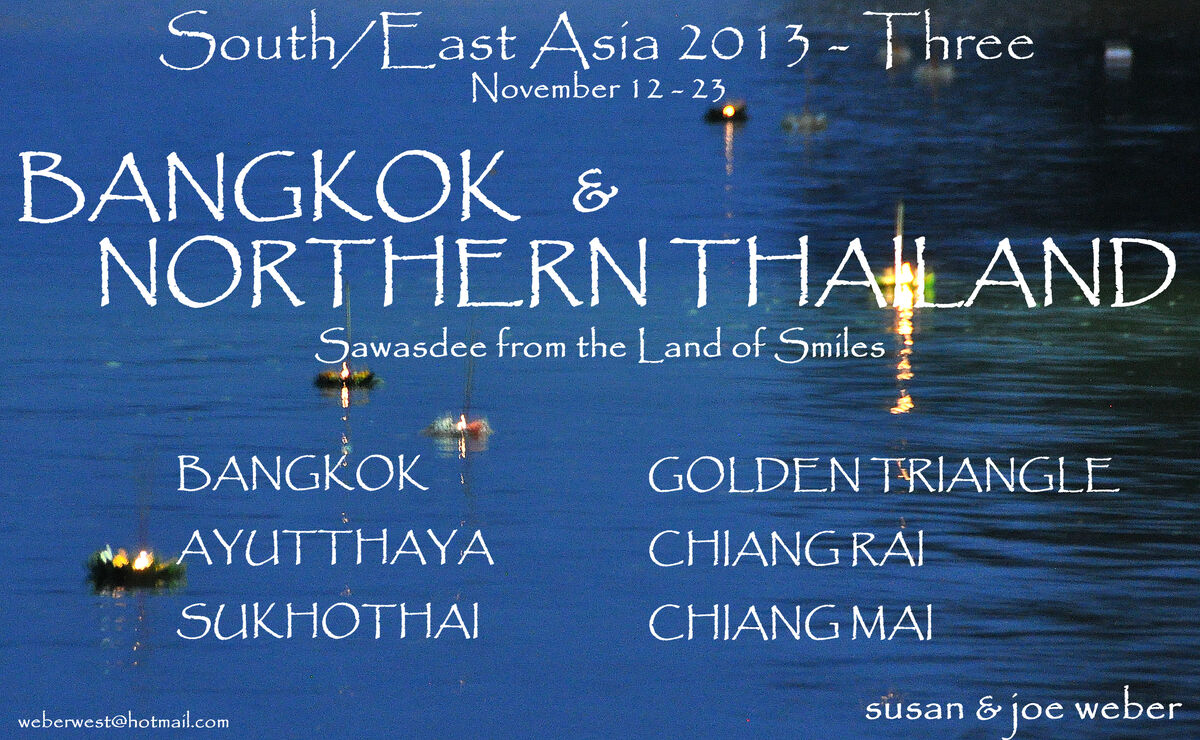
(Download)
2 - Map of our overall trip to South & East Asia to identify Thailand's location in South East Asia and how we got there
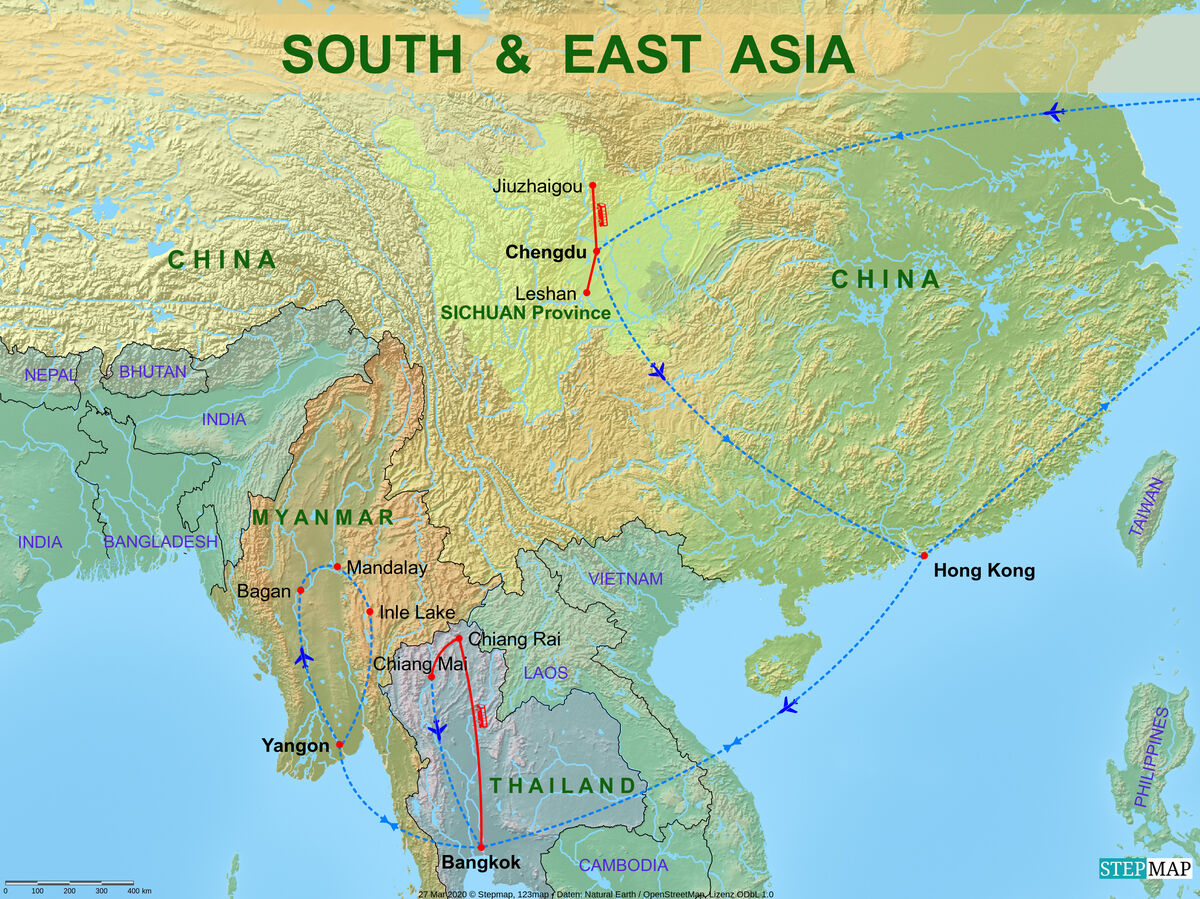
(Download)
3 - Map of our itinerary in Thailand: After briefly visiting Bangkok we move by bus north to Ayutthaya and Sukhothai before reaching Chiang Rai and visiting a few spots in the "Golden Triangle", then heading southwest to our final stop in Chiang Mai
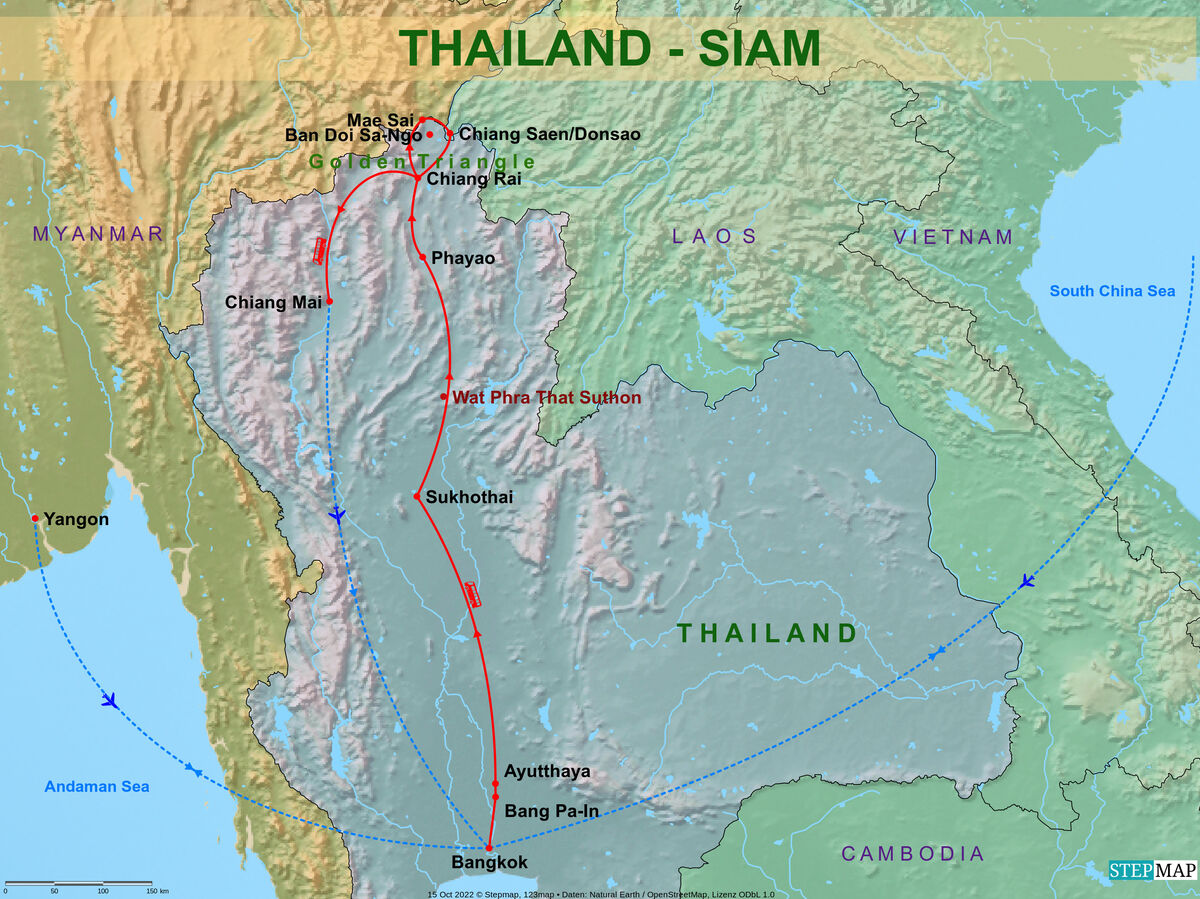
(Download)
4 - Bang Pa-In/Royal Summer Palace: Thai-style Aisawan Thiphya pavilion
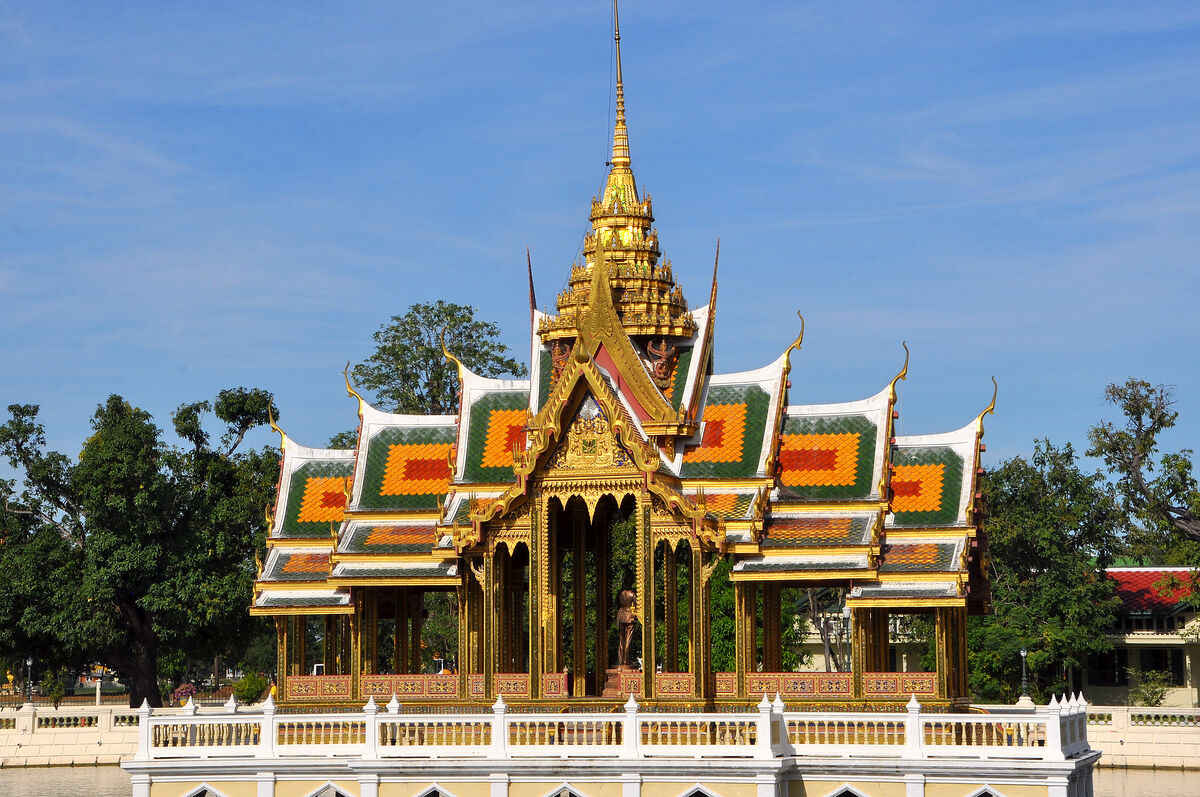
(Download)
5 - Ayutthaya: School children sitting on the floor with their bowl of noodle soup
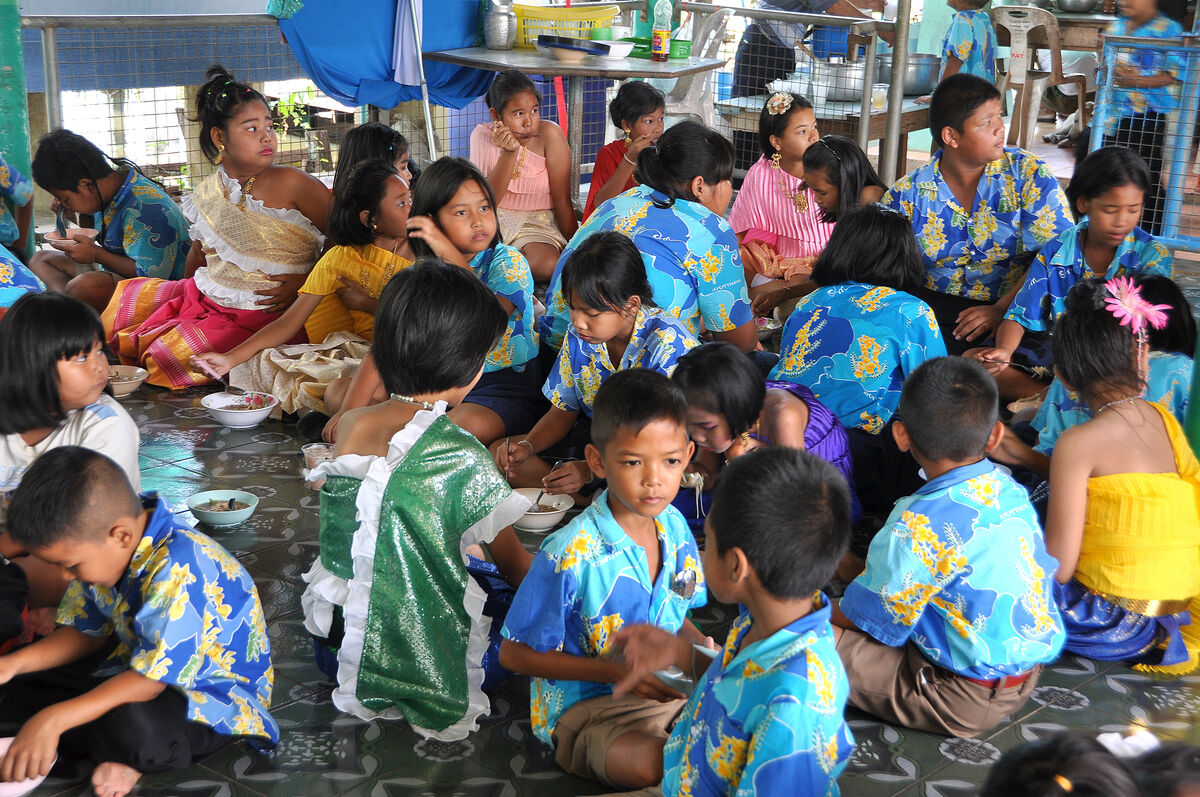
(Download)
6 - Sukhothai: Beautifully decorated Loy Kra Thong Flower Floats
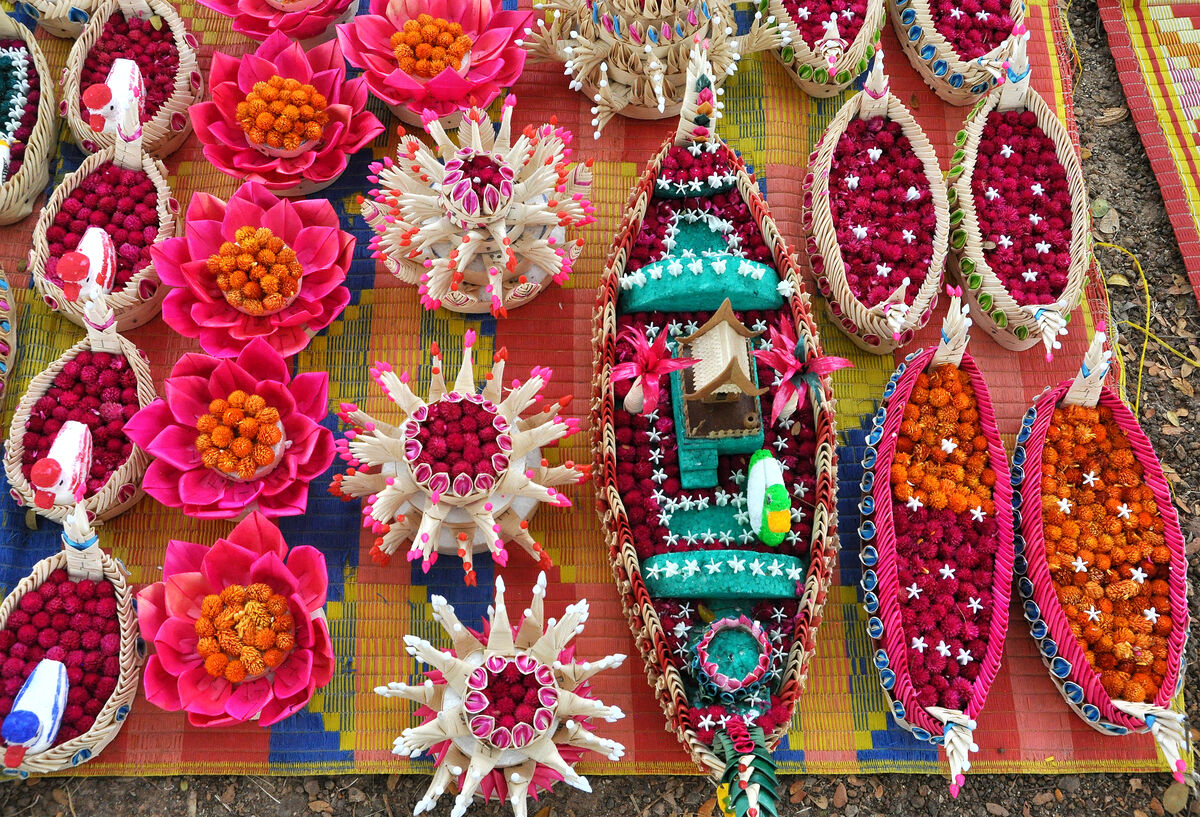
(Download)
7 - Chiang Rai: Wat Rong Khun (The White Temple), a contemporary, very unconventional temple built in 1997
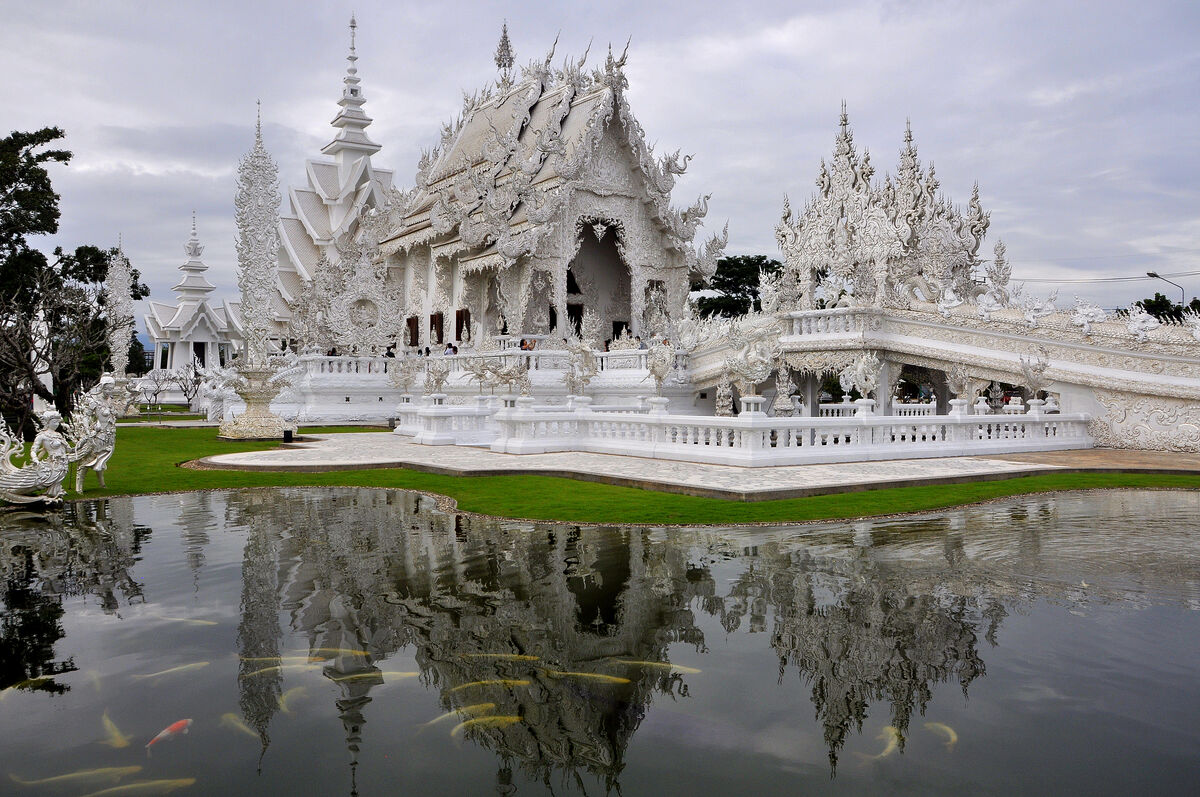
(Download)
8 - Ban Doi Sa-Ngo in the Golden Triangle area: A woman from the local Akha hill tribe dressed in her tribal fineries
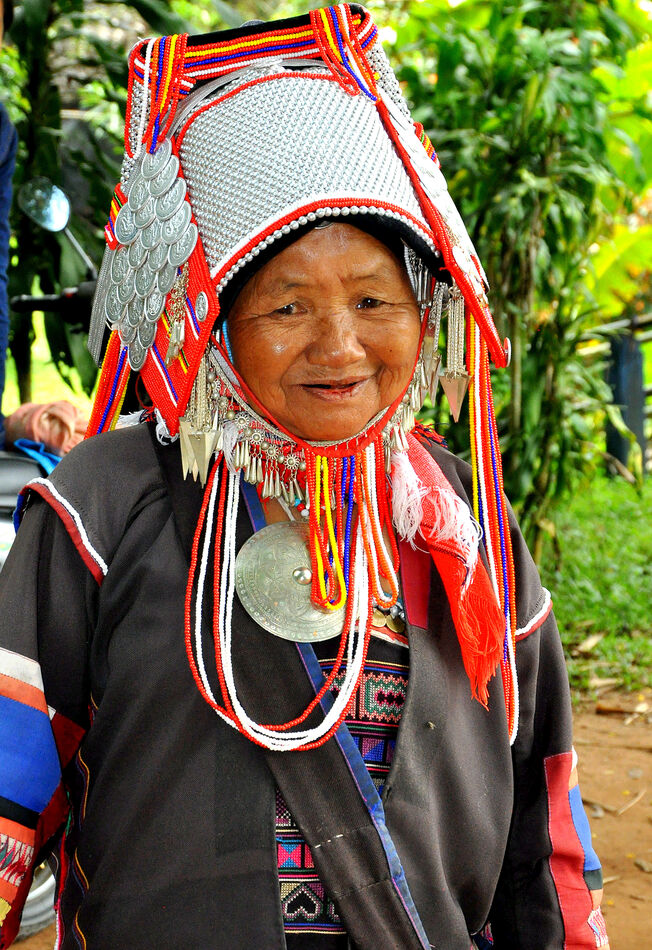
(Download)
9 - Chiang Mai: Wat Phra That Doi Suthep: Statue of a sitting Buddha in front of a richly decorated wall
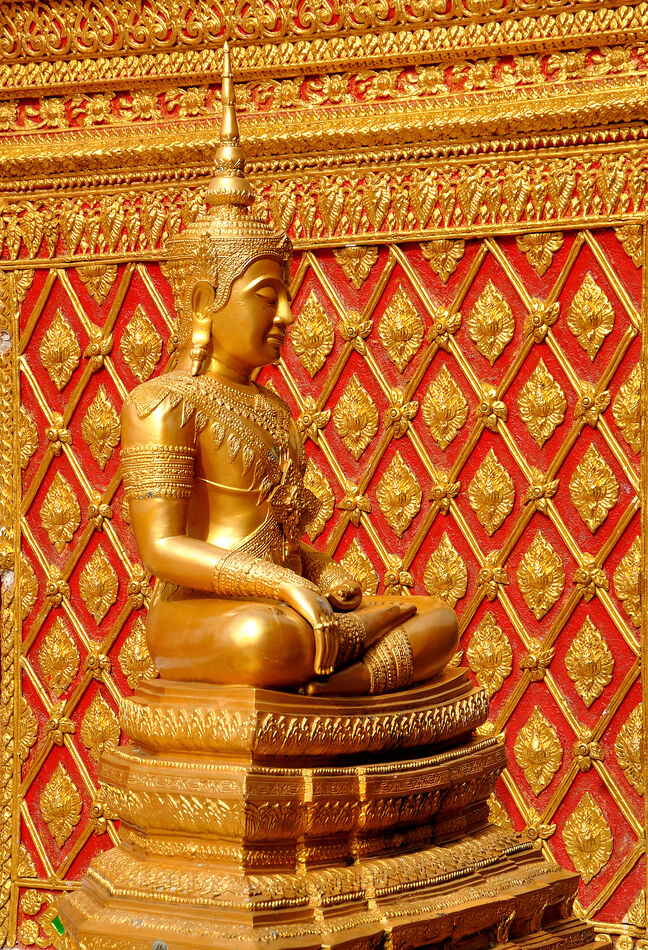
(Download)
10 - Chiang Mai: Purple orchid flowers
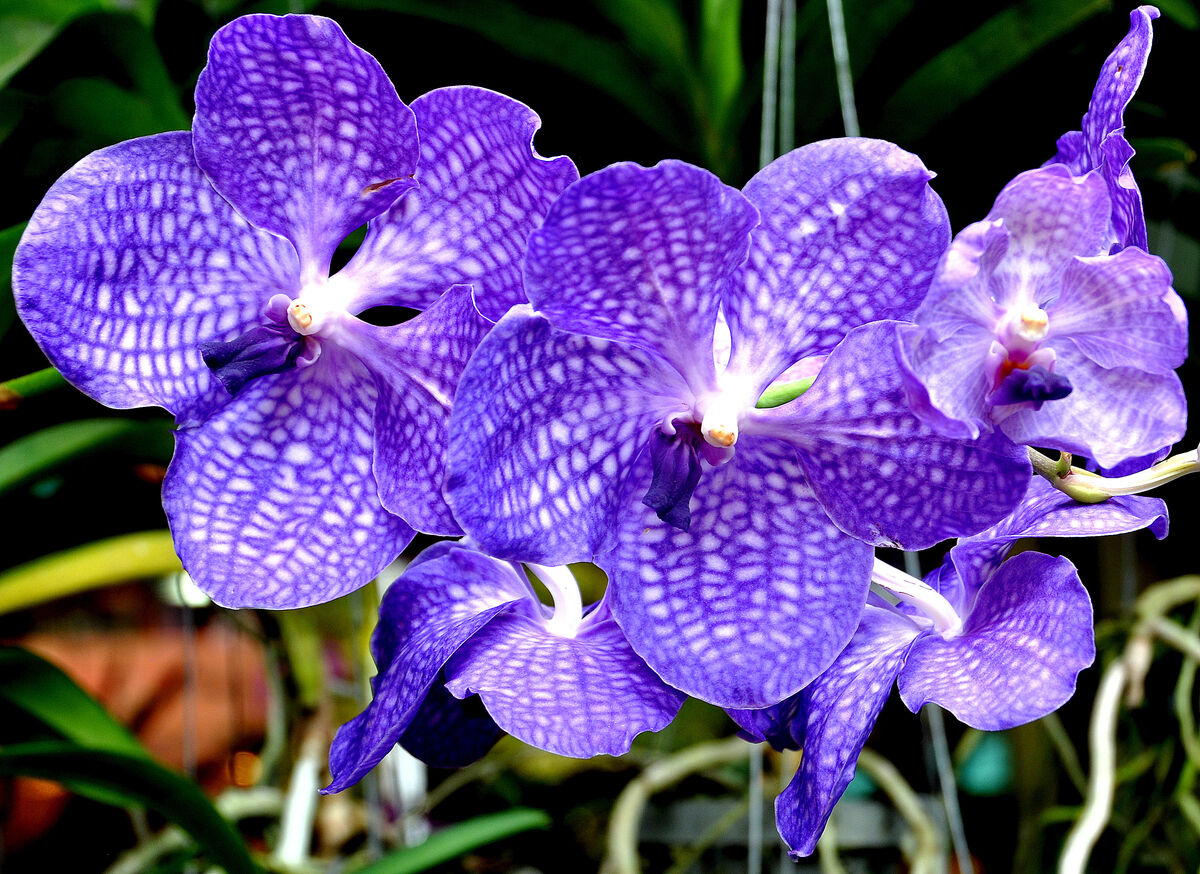
(Download)
Oct 24, 2022 11:07:32 #
Oct 24, 2022 11:08:04 #
Oct 24, 2022 12:31:05 #
Longshadow wrote:

Thank you Bill for looking in on the continuation of the series!
Oct 24, 2022 12:31:58 #
UTMike wrote:
An intriguing and colorful start, Joe!
Thank you Mike for your kind comment!
Oct 24, 2022 12:39:08 #
Oct 24, 2022 13:28:31 #
NMGal wrote:
Gorgeous series. The floats are exquisite.
Thank you Barbara, yes these floats are really small artistic creations, we were very fortunate to be there at the time of this festival, and will be seeing quite a bit of these floats over the course this new Thailand section. Thanks for looking and commenting - I very much appreciate it.
Oct 24, 2022 17:02:51 #
Oct 24, 2022 17:16:39 #
kpmac wrote:
A really nice set, Joe.
Thank you Ken, Northern Thailand was quite an interesting place, particularly culturally and I hope I can bring you all some interesting images from this place.
Oct 24, 2022 19:44:36 #
Welcome home and welcome back Joe!!! Great start to this ongoing series from SE Asia. I was especially drawn to all the locals in this series but that white temple shot is really cool!!
I'm looking forward to trying to keep up with your daily posts. (you know why I can only "try").
So good to have you back on the Hog!
Rob
I'm looking forward to trying to keep up with your daily posts. (you know why I can only "try").
So good to have you back on the Hog!
Rob
Oct 24, 2022 20:29:16 #
Umnak wrote:
Welcome home and welcome back Joe!!! Great start to this ongoing series from SE Asia. I was especially drawn to all the locals in this series but that white temple shot is really cool!!
I'm looking forward to trying to keep up with your daily posts. (you know why I can only "try").
So good to have you back on the Hog!
Rob
I'm looking forward to trying to keep up with your daily posts. (you know why I can only "try").
So good to have you back on the Hog!
Rob
Thank you Rob, good to hear from you and yes, it feels good to be "back in the fold", it has been a long absence, but I am really looking forward to continue this series, now in Northern Thailand. There will be a fair number of people images and of course lots of temples and Buddhas, unfortunately not too much landscapes, but I will have some of those as well. I appreciate your efforts to keep up with my daily posts, but I understand that with your busy schedule this is not always possible, so don't worry if and when you fall behind, I know that eventually you will catch up again!
Oct 25, 2022 06:04:24 #
Oct 25, 2022 07:51:52 #
weberwest wrote:
After a long absence due to our vacation- and fami... (show quote)
Another amazing series Joe. Thank you so much for sharing your journey


Oct 25, 2022 08:06:50 #
Oct 25, 2022 08:18:28 #
If you want to reply, then register here. Registration is free and your account is created instantly, so you can post right away.





